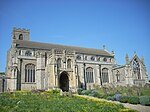Wiveton
Civil parishes in NorfolkNorth NorfolkVillages in Norfolk

Wiveton is a village and civil parish in the English county of Norfolk. It is situated on the west bank of the River Glaven, 3 km (1.9 mi) inland from the coast and directly across the river from the village of Cley next the Sea. The larger village of Blakeney is 2 km (1.2 mi) to the west, the town of Cromer is 20 km (12 mi) to the east, and the city of Norwich is 40 km (25 mi) to the south-east.The civil parish has an area of 4.25 km2 (1.64 sq mi) and in the 2001 census had a population of 158 in 74 households, the population reducing to 127 at the 2011 census. For the purposes of local government, the parish falls within the district of North Norfolk.
Excerpt from the Wikipedia article Wiveton (License: CC BY-SA 3.0, Authors, Images).Wiveton
The Street, North Norfolk
Geographical coordinates (GPS) Address Nearby Places Show on map
Geographical coordinates (GPS)
| Latitude | Longitude |
|---|---|
| N 52.94427 ° | E 1.03909 ° |
Address
The Street
The Street
NR25 7TJ North Norfolk
England, United Kingdom
Open on Google Maps










